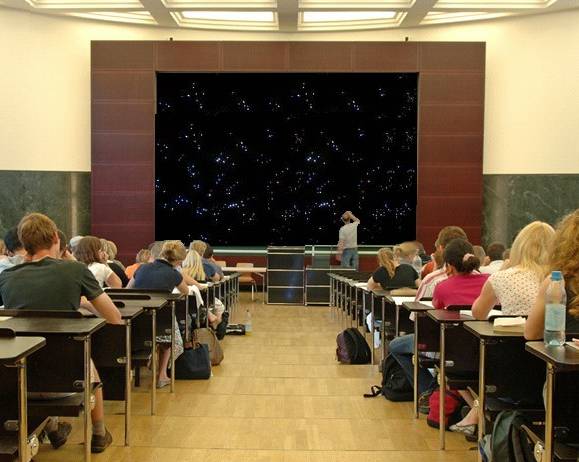
Materials
The basic components of a star ceiling system are PMMA (plastic) fiber in multiple diameters, and a light source.
More sophisticated effects are being achieved by organizing (mapping) the fiber in the input and installing multiple light sources (or circuits, when using LEDs) controlled using DMX2.
Holes drilled in the ceiling accept individual fiber strands. The other end of the fiber is collected in a common input, terminated, and inserted into a light source. The light source is placed in the ceiling or in a nearby closet. LED, Quartz halogen, and HID light sources are typical light sources for star ceilings.
As the star field technique gained notoriety, several manufacturers developed “kits” for sale direct (via the internet) or through distribution as DIY products.
The kits consist of a pre-made fiber harness and light source. The end user or contractor is responsible for designing the star field, bringing power to the LS, installing the fiber and wiring the light source. Kits are convenient. Because they are pre-made, the terminations are high quality (far less likely to burn or melt), and there is no measuring, or cutting (so far fewer mistakes are likely) However, kits are restrictive, making them limited in application to smaller room areas (10×10 maximum) in most cases. Another drawback to the pre-made fiber kits is the unnecessary amount of fiber used. The user is then expected to run the fiber directly from the light source to all desired points of the ceiling to install. Not only does this create a difficult web above the ceiling, it also leaves the user with wasted fiber since some runs do not require the full length of fiber supplied.
Still other suppliers, including FTI, offer a pre drilled/pre-installed fiber in 2×2’, 2×4’ and custom sized acoustic panels per architect’s spec. In some cases, the customer or contractor is required to create the common end, make the connections, and wire the LS. FTI’s version is slightly different and more user friendly. As each panel is self-contained with a small LED light engine and fiber, and designed to drop into a suspended ceiling tacking or mount directly flush to drywall, each panel simply daisy chains to the next. The fiber supplier may drill and install the star field, but hanging the panel and bringing power to the spot where the light source is located are the customer’s (Contractor’s) responsibilities.
FTI offers a hybrid system combining the convenience of a kit, with the versatility of a custom installation.
Technical Considerations
Fiber
Almost all designs use plastic (PMMA) fiber in several diameters.
.75mm fiber is the base size for the star field effect. Using various diameters, as well as varying the fiber-end distance from the ceiling improves realism. The recommended sizes are 5mm, .75mm, 1mm, (as well as 1.5mm, and 3mm on rare occasions).
Typically unjacketed fiber is used. If the ceiling is translucent (perforated, for example) it would be wise to use jacketed fiber to prevent the ceiling from glowing.
Sometimes, acrylic shapes are side lit to create certain shapes (the rings of Saturn, for example)
Light source
In most kits, the light source of choice is the low wattage quartz halogen LS. Semi-custom kits use Quartz Halogen or HID. Most FTI solutions incorporate LED light sources for the convenience of our customers. LED light sources have a long life, some of over 50,000 hours, so there is no need for the inconvenience and cost of replacing bulbs frequently. LEDs are also beneficial to the customer’s safety considerations as they produce very little heat and typically require only a 5 – 12V power supply.
Please visit our light source page for general light source information and view our complete selection.
Heat and lamp maintenance are the major “design challenges” to overcome when using Quartz Halogen or HID lighting. Typically, the light source is installed in the ceiling, requiring additional electrical outlets or wiring the LS directly into an existing light circuit. As a matter of convenience, the LS should be located in a closet (for convenient lamp changing) but this limits the pattern coverage when using an off-the-shelf kit; unless an extension bundle is used, or the user opts for a custom installation.
Design
In real life, the distribution of stars in any given field of view is random. However, we tend to be uneasy with large voids and have an urge to balance the star effect, which reduces realism. This urge must be avoided. Take a look at the night sky; you’ll see clusters of stars and large distances of open space. This is the approach you should execute for the most pleasing effect. Of course, if your goal is a commercial lighting effect for visual interest, feel free to experiment.
Many people envision a duplicate of the sky, or hope to approximate constellations. Patterns can be used for this approach, but the effort is typically not worth the extra time and cost investment, as the scale of most installations is too small (Ceiling too close, star area too small) for the effect to be easily recognizable. However, the one exception is the big dipper, which can be easily managed and recognized.
If you’re reluctant to take on the challenge of star field layout, Sandy Jeakins, a trained engineer and Starscape customer developed a layout idea that works well for ceilings (with access from above) already in place. She placed dimes and pennies on the floor, experimenting with the layout until it looked right.
Even though the size differential of the penny and dime does not equate directly to fiber size (which created some clutter on the floor) she was able to compensate in her mind. Once satisfied, she made a simple fixture to hold a laser pointer, which she then placed over each coin. This located the drill point on the ceiling, which was then drilled and fiber inserted.
Site location is an important consideration. In the city, fewer stars are seen by the observer than compared to looking at the same sky in the suburbs or a rural area. For general consideration, 1-3 stars per square foot can be seen from a city perspective, 3-4 stars per square foot from the suburbs and much higher densities (5-7 stars per square foot) in rural areas.
Most installations use 3-4 stars per square foot to simulate a night sky. This number can also vary with the type of light source used, ambient lighting in the space, the distance of the star field from the viewer and the desired effect. That is, to create the illusion of a galaxy, densities 2-3x the above are required. To see an example of different star densities, click here.
Motion can be created by a special placement of the fibers in the common end (known as mapping), combined with the use of electronic control. DMX (Digital MultipleXing) control is a serial communication technique used to remotely manage light output (dimming, on/off) of several light sources. In addition, color/twinkle wheels are also controlled…their speed, direction, and start/stop times are controlled thru a “DMX” controller. Shooting stars and spinning nebulae effects can be achieved. Most home star ceilings do not use DMX. Most homes desiring a shooting star and twinkle effect use, and can be achieved using, LED add-on kits for desired effects. A circuit board inside the LED light source will typically allow the user to control dimming and frequency.
FTI is proud to offer a wide variety of star ceiling solutions and products to fit almost any application or desired effect.
Need more information? Contact us.
